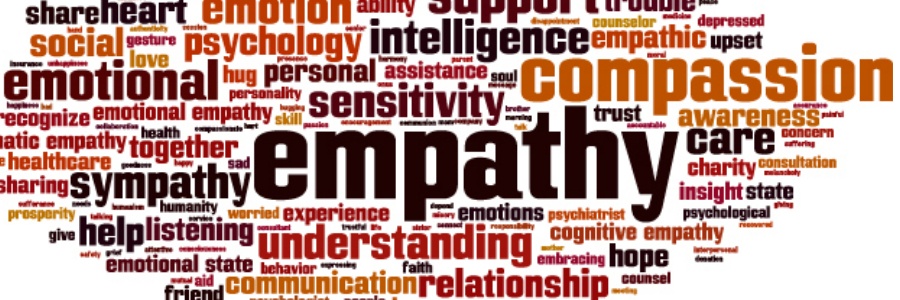
Infographic: Black Friday 2018, Naughty Or Nice For Retailers?

Topics: black friday, consumer experience, in-store surveys, foot traffic
Cold, Hard Survey Data Isn’t Cold or Hard when it Reveals Consumers’ Emotions

Empathy is indispensable to strong friendships, marriages, and any other rewarding human interaction. For brands, forging empathetic bonds is the essence of winning customer loyalty. Consumer insights pros have a pivotal role to play in empathy building, since they are the observing eyes and attentive ears who collect the data that leads to understanding, without which there can be no emotion-based connection.
A recent article posted online by the Harvard Business Review explores new ways of training employees to understand and empathize with the customers they serve. It lays out a four-step process that, significantly, begins with “Gathering insights. What is broken, frustrating, surprising or uncomfortable for your customer?”
The article, “To Get Employees To Empathize with Customers, Get them To Think Like Customers,” proposes a bit of unusual game-playing to put employees in customers’ shoes. Authors Erin Henkel and Adam Grant suggest that managers identify a business in an unrelated industry that interacts with customers in ways comparable to the one trying to up its customer-empathy game. Then it sends employees to have a customer experience with the mirror brand, and see how it feels to need service and see where it succeeds or falls short. The idea is that there will be more freedom for discussion if their own company’s policies and execution are not the direct subject of a customer-empathy discussion.
“It takes time and energy to design these experiences,” the authors write, “….but we’ve found them to be a powerful way to ensure that the people in your organization truly understand their customers.”
The challenge for any brand as it tries to understand “what is broken, frustrating, surprising or uncomfortable for your customer” is to strike while the emotions and experiences are hot.
Too often, the data harvested via consumer surveys reflects stale memories, and little, if any emotion, because emotion often flares during and directly after an experience, but quickly subsides.
In an act of empathy for marketers and market researchers, we’ll lay out the bones of our solution, which we call survey research at the Point-of-Emotion®.
First comes the not-so-secret ingredient: a first-party consumer panel of representative U.S. consumers.
Next comes the unique, proprietary ingredient: Surveys On The Go® (SOTG), the research industry’s most advanced and reliable mobile app for locating and surveying consumers during their buying journeys. We’ve empathized with our app-users by giving them great mobile experiences that satisfy their demand for smooth-functioning, fun experiences on their smartphones
Since its debut in 2011, SOTG has received consistent ratings of 4.5-stars out of 5 at the Apple and Google Play stores. Our users’ satisfaction gets you the engagement you need for fast, accurate data.
The right people, engaged by the right technology, gets you the right-now, right-place data you need to uncork emotions and experiences before they’ve gone flat due to the passage of time. You can field surveys while your audience is still in a store, or wait until they exit for a post-visit survey that captures their entire experience.
For an empathetic discussion of how mobile-app location studies can meet your projects’ specific needs, just get in touch by clicking here.
Topics: point of emotion, geolocation, market research, consumer insights, in-app Mobile surveys, consumer experience
A Survey of Restaurant Customers Shows How Data Can Capture Emotions

Here’s a consumer insights finding from the world of quick-service restaurants (QSRs) that should resonate with marketers and researchers in other industries as well: it’s not just their wallets or taste buds that are driving consumers' choices. It's their emotions.
MFour fielded a mobile geolocation study and collected survey data from more than 2,000 GeoValidated® QSR customers of seven leading national brands. The results underscore how important it is for brands to understand the role emotion plays in propelling buying decisions.
Located and surveyed just after they'd left a QSR, respondents were asked their single most important reason for choosing that brand on that day. They were given 18 possible motivations, and picked just one. Having a “craving” for their choice's offerings – a completely emotional experience – was the highest-ranking answer.
- 23% chose “I was craving” [the brand].
- 18% chose “it was the most convenient for me today.”
- 15% chose “[the brand] is affordable.”
Respondents had been drawn almost equally from among the seven QSR brands, and were geolocated at a store. They were required to complete the questionnaire within 24 hours.
Unlocking the emotional component of buying decisions – the cravings, sense of excitement, urgency, or other feelings that loom so large – requires these three indispensable inputs:
- GPS-powered mobile geolocation technology that’s a unique capability of smartphones
- An all-mobile, first-party consumer panel whose members can be located in the right places at the right time so they can respond to mobile surveys while emotions are still fresh.
- A state-of-the art mobile survey app.
The Surveys On The Go® app gives you all three. If you’re ready right now to talk about how in-app mobile research capabilities can put you in touch with shoppers' emotions to gain the fullest understanding and achieve your brands' business goals, just click here. And if you'd like to take a deeper-dive into how it works, read on.
A validated, representative mobile consumer panel is paramount. More than 2.5 million U.S. consumers have download Surveys On The Go® (SOTG), motivated by the opportunity to take part in research while earning cash rewards. In-app mobile surveys gratify respondents' entrenched desire to have seamlessly engaging experiences on their smartphones.
- Once they’ve downloaded SOTG, users give their informed permission to let the app access to their phones’ location services, so they can be tracked through all their buying journeys and qualify for location-specific studies.
- Location studies such as the QSR survey track consumers' natural store visits and identify them as soon as they have arrived at a place that’s relevant to the research project at hand.
- Once detected in a desired location, consumers receive an in-app push notification alerting them to a survey opportunity.
- The push can arrive while they're still in the store, or just after they've left; in-store surveys document the shopping experience prior to purchase, and after-visit surveys also capture the purchase itself.
- Either way, researchers are reaching respondents at the Point of Emotion® at which buying decisions come to a head.
- Expect response rates of 25% within an hour, and 50% within 24 hours -- compared to the industry norm of 1% to 5%. The differentiator is the unique mobile-app experience.
In the case of the QSR preferences study, respondents were required to complete the survey within 24 hours of their visit. There’s little point in asking a QSR customer the most important reason for his or her visit more than 24 hours after the fact. By then, the Point of Emotion® is long gone, and any response will be rife with recall bias. Ask yourself whether you can remember your most recent visit to a QSR, and state your most important reason for choosing it. If you're not an extremely loyal, extremely frequent customer of a particular brand, you might struggle to answer.
To sum up:
The only way to get a fully-recalled, emotionally-informed understanding of consumers’ preferences and motivations is in-app mobile research with an engaged, first-party mobile panel.
If you have a craving for this kind of data, let's talk. Just click here.
Topics: mobile surveys, geolocation, market research, consumer insights, consumer experience, quick serve restaurants
Don't Underestimate what Mobile News Consumption Means to Market Research

Should the news that news consumption is overwhelmingly mobile matter to marketing pros and the market research industry? Should it matter to skiers whether there’s snow on the mountain?
For good reason, news organizations are scrambling to meet consumers on mobile, because that’s where news consumers have gone. Those who’ve been able to offer a great mobile product are gaining readership and revenue, while those who can’t seem to get mobile right continue to fade. Similarly, amid industry-wide malaise in market research caused by falling survey participation and crumbling data quality, it’s past time to go all-in with mobile data-collection and get it right. There’s simply no other way forward.
Pew Research Center’s most recent checkup on the state of news consumption underscores that it’s no longer news that mobile has taken over in nearly every phase of life. Skiers who are trying to stay upright during a downhill run may be among the few identifiable groups who are certain not to be using their smartphones at any moment. Or so one hopes.
As snow is to skiers, mobile is to the job of trying to understand consumers. It’s simply the medium in which information activity occurs. Without snow, there’s no skiing. Without mobile news publication, there’s no audience. Without mobile consumer data, there’s no way to understand consumers. And without a way to understand consumers, the news about market research and the businesses that depend on it for smart decision-making probably won’t be good.
Here are key data points from Pew’s study, which was conducted in 2017.
- 58% of U.S. adults often consume news on mobile, compared to 39% on personal computers.
- Mobile news consumption rose 176% from 2013 to 2017, compared to an 11% increase over the four years in news access via laptops and desktops.
- Younger news audiences are even more heavily invested in mobile: 71% of 18- to 29-year-olds say they often get news on mobile, as do 67% of 30- to 49-year-olds.
- In fact, among 17 demographic segments Pew focused on in its summary, spanning age, gender, race, income, education and political party, just one group, respondents over 65, said they most often used PCs rather than mobile to get the news.
To make a long story short, consumer insights pros and the decision-makers who depend on them for data they can trust need to focus on three key words: “GET MOBILE RIGHT.”
Start with that as your motivation, and we’ll help you get where you need to go. To set up a productive conversation about how to get mobile right as you seek solutions to your projects’ specific needs (including adding mobile to trackers), just click here.Topics: mobile research, market research, consumer insights, data quality, surveys, consumer experience
Inconveniencing Consumers Is a Killer for Market Research, Too

Here’s a consumer insight that retailers can etch in stone: if you don't make shopping easy and convenient, consumers will abandon you, and competitors who do it better will swoop in and grab them and their wallets for themselves.
A recent RetailDive mobile commerce newsletter gives further evidence that inconvenience is a killer. It reports a recent study by Splitit, a digital payments solutions company, in which 87% of online shoppers surveyed said they would abandon their shopping carts during checkout if the process was too difficult – with 55% saying they would never return.
Inconvenience also is a killer for consumer research, because consumer research is, in fact, a B2C sell. If this assertion surprises you, it’s time to take a broader view.
Yes, consumer research is, of course, a B2B transaction between research suppliers and their clients. But what’s being supplied and bought is consumer data. And there will be no consumer data, or at least none worth having, if you fail to sell consumers on providing it in an engaged and thoughtful way. So before it can become a B2B offering, consumer research needs to be a B2C success.
If you make it inconvenient for consumers to access research experiences and fail to make those experiences easy and enjoyable, you’ll end up with the equivalent of those abandoned online shopping carts – too few consumers, too little reliable data, and, eventually, not enough business to sustain your research enterprise. Unrepresentative data, insufficient data and unreliable data are certainly beyond-inconvenient to the ultimate consumers of consumer research: the business decision-makers who expect reliable guidance grounded in validated consumer reality.
MFour’s value proposition is quality mobile data made possible by an engaging, pain-free, and seamlessly convenient survey experience for the consumers who download our standard-setting mobile research app. More than 100,000 of our Surveys On The Go® (SOTG) app users have spoken for themselves about their experiences by posting comments and ratings in the Apple and Google Play app stores. SOTG perpetually enjoys an average rating of 4.5 stars out of 5.
Here are other metrics that reflect what our survey-app users' convenience and satisfaction have meant for MFour's clients:
- 25% response rates within an hour, and 50% within one day.
- 95% completion rates for surveys with LOI of 20+ minutes.
- 85% participation in follow-up surveys for consumer diaries and other multi-phase studies.
The takeaway is that the people on our panel are not checked out from consumer research. To learn what that can mean for your specific research projects, just click here.
Topics: mobile research, consumer insights, data quality, retail, consumer experience

